MENU
> Watch Gangoji > Hotoke, or Buddha, at Gangoji
Click for details.
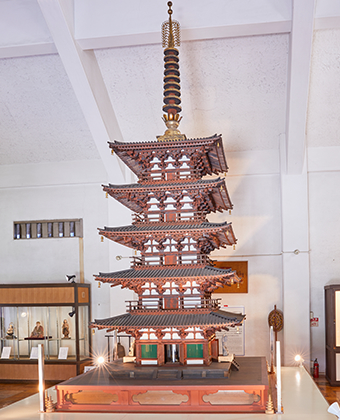
National treasure
It is said that a five-storied miniature pagoda was enshrined in Gangoji, Nishi-Shoto-do (the west small tower house), which was built ath the behest of Empress Komyo. This five-storied miniature pagoda is well-known as the oldest existing one made during the prosperous times in the Nara Era. The tower axis columns stand at the regular interval of 1.8m. When going up from the first story, the interval between the columns are reduced by 3cm. This miniature pagoda was precisely constructed into the details, and it is said to have been a one-tenth-sized prototype of the tower in Kokubun-ji temple. Before the modern times, Gangoji lowered the floor of Gokuraku-do Hall to store this miniature pagoda.
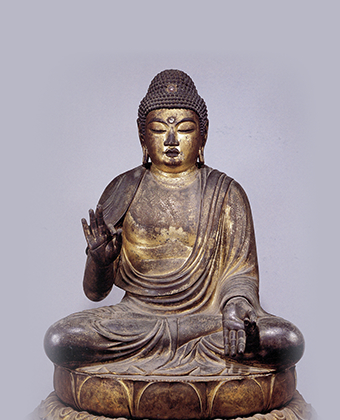
Nationally designated important cultural property
It is believed that Amida Nyorai (Amitabha Tathagata) still today continues preaching in the Buddha’s Pure Land, which is tens of millions of miles away from this world. Amida Nyorai is also called “the Buddha of Immeasurable Light” or “the Buddha of Immeasurable Life”. In general, she appears in the three different types of pausing: meditation (Jo-in), Shoten-porin (Seppo-in) (the first time Buddha preached Buddhist doctrine to people) and Tsusetsu (Raigo-in) (welcome deceased people). This 2.425-meter high statue shows the upper grade lower birth mudra. She pauses the lower birth mudra by bringing her index fingers and thumbs to touch. This pausing is called “Raigo-no-so”, to welcome the spirits of the deceased people. The assembled material seemed to be Miscanthus in an inverted T shape. Carved from one solid piece of wood, with the plastic clay partially and thickly applied over the base wood, gold leaf was also applied. It is a good example of the profound artwork made in Nanto in the middle of the 10th century.
The principal image of Taho-to possessed by Zentei-in of Gangoji Betsu-in and Daijo-in of Kofuku-ji temple moved in the Muromachi Era and had been placed in Gokuraku-do by the Meiji Era.
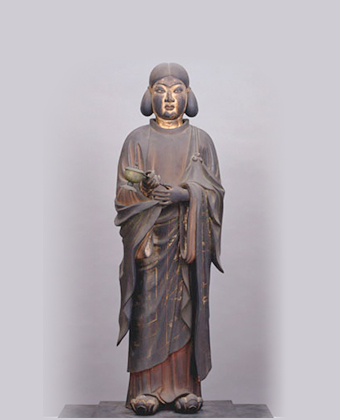
Nationally designated important cultural property
Prince Shotokuwas sometimes regarded as the incarnation of Kannon, or as the first person who went back to the Buddha’s Pure Land. This theory produced his biography and he has been described based on the appearance of Kannon. The Koyou-zo is a wooden carved statue, describing a 16-year-old Taishi praying for his father (Emperor Yomei) to recover from illness. This statue has Mizura hair, a bunch of hair is wrapped round and hangs beside the ears, and wears a vermillion colored outer robe and Hakama trousers, putting a priest’s Hichijo Toyama Kesa stole on his right shoulder. He holds an incense burner with a handle by his right hand, and pulls his right sleeve with his left pinkie finger.
Gangoji was regarded as “the most picturesque temple among the forty-six temples related to Prince Shotoku”. At that time, the worship of Prince Shotoku rose among the priests who put value on Buddhism percepts in Nanto, and they made Gokuraku-bo the base of Taishi faith. This movement brought an opportunity to establish a statue of Prince Shotoku at Gangoji. The items stored inside the statue revealed that Gansei and 5,000 priests and secular people formed a connection by establishing this Prince Shotoku statue. It was established in 1272 in commemoration of the 650-year anniversary of Prince Shotoku’s birthday. About Prince Shotoku faith at Gangoji
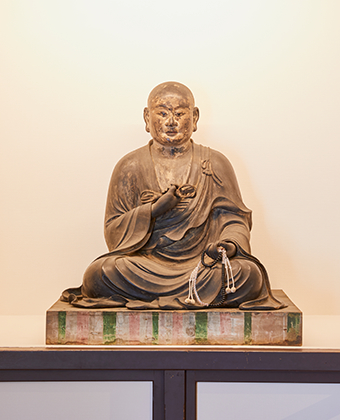
Nationally designated important cultural property
Kobo Daishi Kukai became a pupil of Gonsou at Daian-ji temple, and received a percept from Yasunobu Wajo, Gangoji temple at the ordination platform at Todai-ji temple. Some scholar priests at Gangoji, such as the priest Yasunobu, Chukei, and Gomyo, had close relationship with Kukai.
Kukai went abroad to study at Seiryu-ji temple in Tang. He inherited Esoteric Buddhism from Keika Ajari and became one of the Shingon-hasso (eight patriarchs of the Shingon mission). From late in the Heian Era, people started to worship him as the founder of the Shingon sect. As interest toward the Daishi faith rose greatly around the 400-year memorial services, his statue was the only one to be built alone. This statue was built during his time, not accompanying any statues. According the prayer written by Ganshuzen, receiving mercy from Kobo Daishi, he wished to die peacefully and went to Tousotsu-ten, the Pure Land of Maitreya Buddha. The statue of Kobo Daishi is not merely a statue of a patriarch, it is enshrined as Maitreya Buddha. The Rishu-kyo (Principle of Wisdom Sutra) was written in red ink, and many dedicated items were discovered from the inside of this statue. It is regarded as one of the most notable Kobo Daishi statues remaining throughout Japan.About Daishi faith at Gangoji
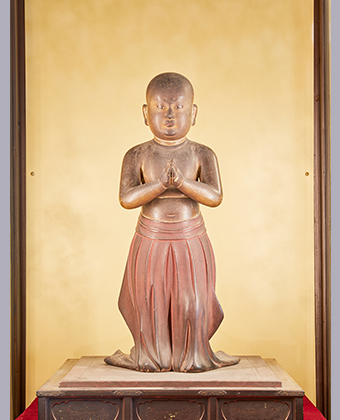
Designated as an important cultural property by Nara Prefecture
According to the biography about Prince Shotoku written in in the Heian Era, on February 15th, when Taishi was 2 years old, he suddenly left the his nanny’s hands, faced to the east and chanted, “Namu Buddha”. It is said that he continued this practice until he was 7 years old. From his folded hands, the Buddha’s ashes of his left eye came out. This ashes has been enshrined in Shari-den hall in Horyu-ji temple. This statue described the moment when Taishi, who was said to be the hierarch of Buddhism, awakened as a Buddhist, linked to the worship of the Buddha’s ashes. This statue also achieves the perfect combination of the childish expression of a 2-year-old infant and the intellectual face of a scared wise person. About Prince Shotoku faith at Gangoji
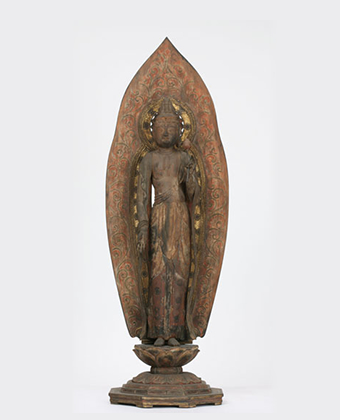
Holy Kannon Bodhisattva (Goddess of Mercy) can also be written as authentic Kannon Bodhisattva, which means the original Kannon Bodhisattva. Kannon Bodhisattva (Kanjizai Bosatsu) is also referred to as “Kouzeon Bosatsu”. Bosatsu (Bodhisattva) means “a person who continues Buddhism practice while seeking enlightenment.” This is the most essential ideology in Mahayana Buddhism. Her appearance is derived from the Buddha before becoming a priest, and she is mostly symbolized with lotus flowers held in her hands. In 1147, the priest Dojaku at Miken-dera temple urged the public to build one thousand statues of Kannon Bodhisattva, which are referred to as “Gangoji one-thousand Kannon Bodhisattva”. The wooden standing statue is one of them. About the faith of Kannon Bodhisattva at Gangoji (Goddess of Mercy)
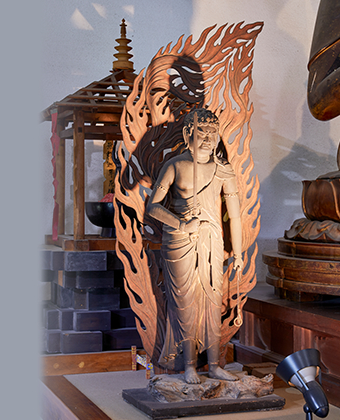
Fudo Myo-o is not only an envoy of Dainichi Nyorai (Mahavairocana), but is also representative of Buddhist practitioners who are the alter-egos of Dainichi Nyorai (Mahavairocana). His appearance is classified into several types as being originated in indigenous ethnic costumes in India. The principal image is close to the Funpon pattern that was drawn by Gencho at Asuka-dera temple in the Heian Era. Considering his slender body and the delicate and moderate patterns consisting of cut gold, it was made from the early Kamakura Era to the late Heian Era.About the Fudo-son faith at Gangoji
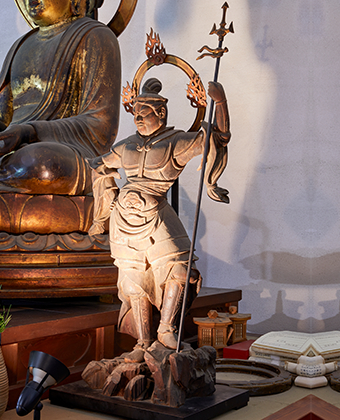
Vaisravana (guardian god of Buddhism) is also known as Tamonten (Vaisravana). He is a head of the Shitenno, the Four Guardian Kings, consisting of Jikokuten (Dhrtarastra), Zochoten (Virudhaka), Kumonten (Virupaksa) and Tamonten (Vaisravana). It is usually depicted as a guardian who devotes himself to protecting temple buildings. This statue looks similar to Zochoten (Virudhaka), but Kurama-dera temple in Kyoto admitted this figure as Bishamonten. The pose of putting his right hand on his waist shows his will to devote his whole body composed of five main parts (a head, a neck, a body, and a pair of upper limbs and lower limbs) to Buddha.
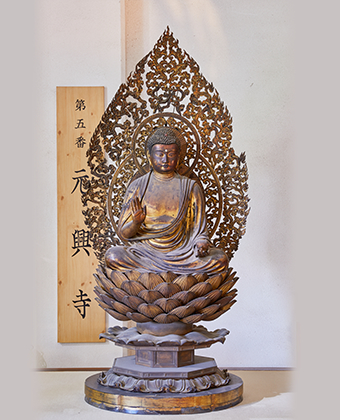
Bhaisajyaguru (Buddha able to cure all ills), also known as Iou Nyorai, is thought to be the previous lives of Buddha, who still preaches in the Eastern Rurriko Pure Land. In general, she holds a medicinal pot in her left hand as a symbol of Buddha of medicine, but some statues don’t. This statue is in the traditional form, but her robe covers her left elbow and foot soles. The wood carving mezzo-relievo describes Horo-kaku, a treasure castle where Buddha lives in the Rurriko Pure Land. The cloth part was engraved deeply and this wooden Amitabha statue made with a piece of wood is very familiar to us.About The Bhaisajyaguru (Buddha able to cure all ills) faith at Gangoji
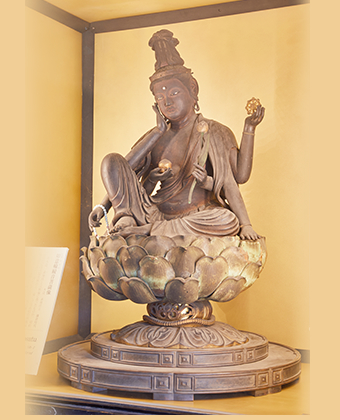
Among Kannon Bodhisattva (Goddess of Mercy), Nyoirin Kannon (the Bodhisattva of Compassion) is more close to Buddhism and Esoteric Buddhism. With the benefit of the cintamani stone and the power of Rinpo, the dharma-wheel (cakra), it is a symbol of public and social fortune for the people. In Nanto, people believed that Shotoku Taishi Was the incarnation of Nyoirin Kannon (the Bodhisattva of Compassion), rather than Kuze Kannon (the Bodhisattva to save the world).
Gangoji Nyoirin Kannon is closely related to the Taishi faith. The statue made into a solid finish inDanzo style looks very simple, but is full of fascinating charm. About the faith of Kannon Bodhisattva faith at Gangoji temple(Goddess of Mercy)
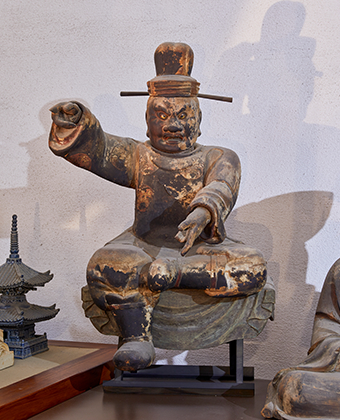
This statue dressed in an official uniform opens a book and reads it. It depicts the scene of an arraignment in the netherworld. The author is thought to be Shukuin Busshi.
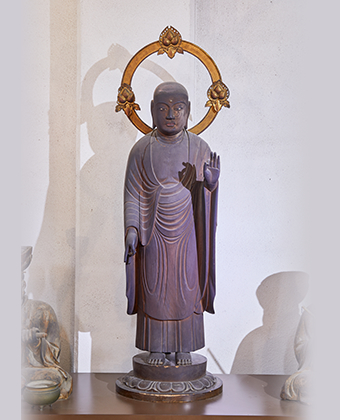
Designated as a cultural property by Nara City
Once Buddha has entered a death state, in the time when there is no Buddha till a Maitreya appeared, Jizo Bosatsu appeared as a priest who worked to save us. During the Middle Ages in Nanto, Jizo Bosatsu were widely worshipped as the third god of Kasugashesashesrine and the Honjibutsu (original Buddhist divinity) of Amenokoyane no Mikoto. Many statues were built. Jizo is usually carrying a sacred gem and a staff, but this statue doesn’t. Its precedent example can be seen in Jizo statues at Kofuku-ji or Yata-dera temples. This statue was made in the Muromachi Era by a sculptor, Shukuin Busshi Sadamasa, who started as a wood craftsman and finally became a Buddhist sculptor. About the Jizo Bosatsu faith at Gangoji
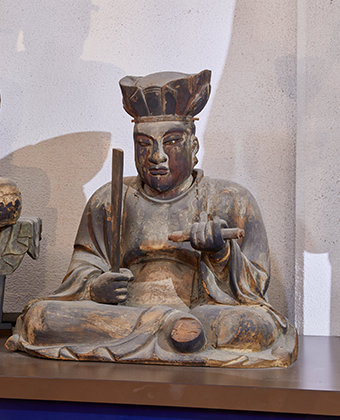
From the late Heian Era, faith in the Jizo Bosatsu as being identical to the Great King Yama was prevalent among the public. Jizo has a nature as Inrou Bosatsu to save us from the base of hell with its endless circle of transmigration in the six posthumous realms. People linked this Jizo nature to the Great King Yama, who is the king of the netherworld. The Great King Yama usually is depicted in anger, but this statue looks calm because it used to be enshrined with the Jizo Bosatsu as a pair.

There are ten kings existing in the realm of the dead as judges. Among them, the Great King Yama (Its original reality is Jizo Bosatsu) judges dead people on the 35th day (7 days x 5) after their death. And the King Taizan (the true form is Bhaisajyaguru) is in charge of the 49th day (7 days x 7) after death. The Buddhist memorial services established in the period of northern and southern dynasties still remains today. In addition to the ten memorial services by the ten kings mentioned in "Yoshu Juo Shoshichi-kyo Sutra" (Sutra of Jizo and the Ten Kings ), it includes the seventh, thirteenth and thirty-third memorial services as well as the thirteenth memorial service (Thirteen Buddhist faith). The combination of the Jizo Bosatsu, the Great King Yama and the King Taizan can be seen in the mezzo-relievo of the Jizo Bosatsu, the principal image at Fukuchi-in temple.
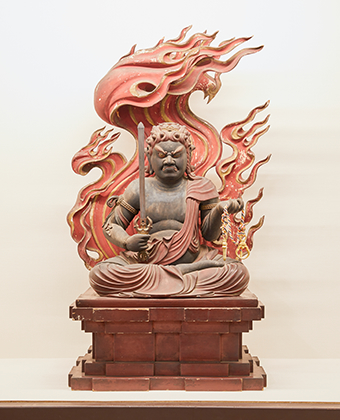
The Sanskrit name of Fudo Myo-o (Acala) is Acalanatha. It is also referred to as Mudo-son. He is also the chief god of the five or seven great wisdom kings, with inflexible determination to aspire toward Buddhahood. He is holding his swords and cord, and living in Kasheso Zanmai (the world of fire). He symbolizes surrendering troubles and disasters. This statue feels like the art style of Tankai Risshi, Chukokaizan at Takayama-ji temple on Mt. Ikoma. Tankai Wajo faithfully and precisely transcribed the Esoteric Buddhist figure images. He attempted to raise his spirit high while being engaged in wood carving and drawing pictures. He also left behind many outstanding Buddhist sculptures in the Edo Era. About the Fudo-son faith at Gangoji
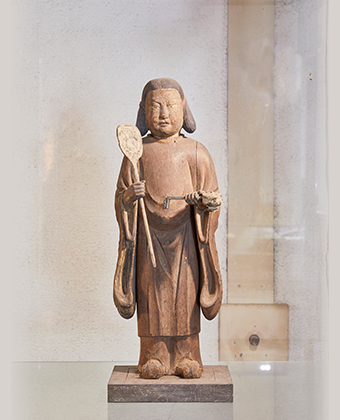
This is the venerable status derived from syncretization of Shinto with Buddhism, the foundation of various Buddhas existing in the three realms, contributing to pursuing happiness and warding off calamities. It appears as a heavenly maiden having gorinto decoration on her head and holding a staff in her right hand and a rosary in her left hand. This figure lost its small tower on her head, but her figure, holding an incense burner with a handle and a fan, looks similar to the Prince Shotoku statue. The well-known statue is possessed by Kongo sho-ji Temple in Asayama, Ise. That statue is considered to be a combination of Dainichi Nyorai (Mahavairocana) and Amaterasu Oomikami (the Goddess of Sun). This is the guardian god of temples in the Risshu sect.

Benzaiten, Saraswati, Goddess of music was deified in the Sarasvati river in India and respected as the goddess of agriculture. She is worshipped as the goddess of music, happiness and prosperity. In the Shingon sect, she is enshrined as a guardian of temples. When the pond existed on the south side of the Zen Room, it seemed to have been enshrined in Nakajima.
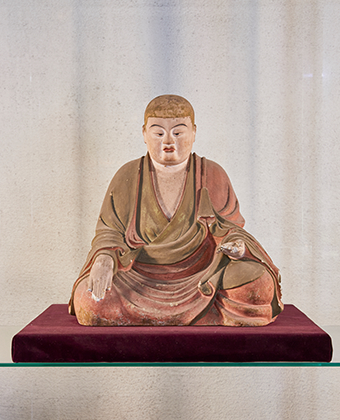
Hachimanshin is the representative venerable status derived from the syncretization of Shinto with Buddhism, as a guardian god of temple buildings. He is usually depicted as Bhikkhu, a Buddhist monk wearing a cloth and referred to as “Hachiman Daibosatsu (Great Bodhisattva Hachiman)”. This statue is a faithful model image of Sogyo Hachimanshin at Yakushi-ji temple, well-known as a national treasure (from the early Heian Era).
Set in the land of beginnings with a history spanning 1,300 years,
Gangoji is a National Treasure and World Heritage Site of Nara.